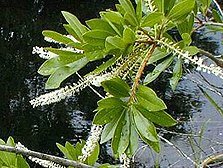
|
 Ironwood Ironwood
Little Goose Creek Branch
|
Colonial Georgia settlers followed the river. From Darien in the coastal lowlands to Fort Barrington 12 miles upriver and on into the wiregrass country, they relied on the Altamaha for transportation, irrigation, and timber. In the vast forests of longleaf pine they cleared small lots, built crude shelter and planted corn, tobacco, sugar cane. Their cattle and hogs roamed freely, grazing on wiregrass, acorns and pine mast.
In the 1770s John and William Bartram's naturalist excursions brought them through the lush Altamaha River watershed, searching for new species of native flora. Camping near Fort Barrington, they identified the overcup oak, 'Quercus lyrata', the Ogeechee lime, and discovered the beautiful "Lost Gordonia" which John named 'Franklinia Alatamaha' after his great friend Benjamin Franklin. The 'Franklinia Alatamaha' is the Bartrams' most famous discovery, and they are credited with saving it from extinction. All Franklinias growing today are descendants of those propagated by the Bartrams at their Philadelphia garden.
|